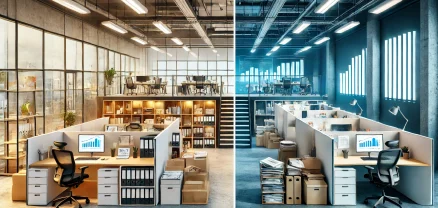The Effects Of Colors On The Psyche Of Employees
Selecting the right colors for a workplace is important, although at first we might not think that colors can effect people’s moods, behavior and performance they do and we have collected the psychological effects of colors and how a variety of hues can help transform your office ambiance.
Green and blue
These two colors can help employees feel calm, relaxed and hopeful. Blue can help lower heart rates, blood pressure and respiration, while green can reduce anxiety. Furthermore the color green is restful on eyes, so it is recommended for use where employees work a lot on computers for instance.
Looking for fresh ideas to grow your business? Consider greening your office with fresh plants or forest-like hues, because researchers have found a direct link between the color green and creativity.
Yellow and orange
Yellow and orange are colors that can stimulate and energize employees, both of them transmit happiness and cosiness. While the color orange can generate enthusiasm in employees, yellow can feel welcoming and, interestingly, help stimulate memories. Both colors, however, may not be desirable as the main color of walls in a workplace, because orange stimulates appetites and yellow can evoke feelings of anger and frustration. Therefore it is best to use yellow and orange as accent colors within the environment, for instance only painting one wall orange, or using this color as an emphasized decorative element.
Red
This color also stimulates employees, and increases brain wave activities, heart rates and respiration. It is easy to overuse this color, therefore it too is recommended only as a sparing decorative emphasis. Employees who work at night may particularly benefit from the color red on walls, because it can help them to stay awake. Deeper shades of red are a range of colors to avoid painting on walls, particularly as a main color because it can stimulate feelings of anger and hostility in employees. On the other hand, pink can have a relaxing effect on employees.
Consider a reddish palette in areas where employees do not spend too much time, such as hallways, bathrooms or even the kitchen.
Neutral and pastel colors
Brown, white, cream and gray colors can help tone down the mind, but mixing with brighter and vivid colors it can create a refreshing and harmonizing atmosphere. Brown walls can create a warm feelings, but can make a room seem dark, which will de-energize employees. Black and dark gray are good accent colors that can add an interesting depth to a room, and provides an elegant business environment but over usage of these dark colors can evoke feelings of sadness or depression in employees.
Of course these were only the main characteristics of a few colors, but being conscious of these factors can be helpful, so be sure to ask an interior designer’s professional opinion when you want to redesign your office.
Check out how we have used colors when we renewed DBH Serviced Office Bucharest!
[sf_button colour=”orange” type=”sf-icon-reveal” size=”large” link=”https://dbh-group.com/en/offices/dbh-serviced-office-bucharest/” target=”_blank” icon=”ss-check” dropshadow=”yes” extraclass=””]Check out the photos![/sf_button]
Source:
Do not hesitate to contact us
Get in touch, if you have any question



